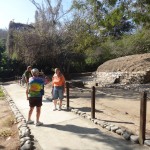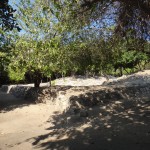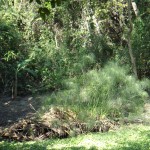Copalita Eco-Archaeological Park : Huatulco – Oaxaca
- Feb 20, 2014
- 3 min read
Huatulco is packed with ancient Indian history. In pre-Hispanic times, the Copalita Eco-Archaeological Park was inhabited by the coastal Tututepec tribe. Later on the Zapotec, Mixtec and Aztec merchants established important trade routes through the region. Coastal navigation was controlled from the town, which remains the only site in which a navigation aid has been found, consisting of an estela (stone monolith) on the top of a cliff to help guide the canoes out at sea. The town was also strategically located on the river banks and near the sea, allowing its inhabitants to exploit fresh water and salt water resources. The main activity of the people of Huatulco has long been fishing, but their ancestors had long established traditions of gathering products for their own consumption and exchanging with other local groups.
We took a short cab ride, $10 per person for about 3 hours, from Huatulco to the site of the Copalita Eco-Archaeological Park: Bocana del Rio Copalita complex and museum. The site, known simply as Copalita, has been in the process of excavation since 1988 by an expert team from Mexico’s Institute of Anthropology and History. Copalita received its name, Copalitlan, a Mexica (Aztec) name in their language of Nahua, meaning Place of the Copal. Sap from the Copal tree was used as incense in Prehispanic rituals and is still burned today on various ceremonial occasions. The old city lies on the ancient boundary between the Mixtec and Zapotec areas.
Are you ready for an experience like this? We are also Travel Agents! Call (607) GET-AWAY to book yours today or Subscribe to our Travel Blog at www.book-a-cruise.info, Follow us on Facebook at Lynn & Rob Belles Cruise One and Belles Firm of Architecture! You won’t want to miss a thing!
This Copalita Eco-Archaeological Park site contains pre-Hispanic remains dating back 2,500 years. We started at the modern museum, where we could have retained a guide – we decided to go it alone, and used the very helpful plaques around the site to gather information about what we were looking at. We were able to wander around the ancient building complex where the ruling class would have lived in the first six centuries B.C.. This included the Templo Mayor (Main Temple), Templo de la Serpiente (Temple of the Serpent), and the Ball Court with its vast stones engraved in low relief. Unfortunately we were only able to see a small portion of the site’s 86 acres.
Emphasis is here has been placed on preserving the archaeological site as it was uncovered by the archaeologist’s. As such, we got to see the remains of the “real” site. A bit disappointing, we were confined to paths and not allowed to walk over the ruins. This is to help preserve the ruins for future visitors.
As we walked through the Copalita Eco-Archaeological Park we were able to see the imposing basal remains of several pyramids – some more than 10 ft in height!. There were four platforms integrated around the site’s ballcourt, and two impressive carved stone monuments. This architectural complex was the civic-ceremonial center of the site of Copalita.
The ballcourt at the site attests to the importance of Copalita site during the Classic period. Ballcourts were “I”-shaped venues where the ancient Mesoamerican elites played a game using a bouncy ball made of rubber from rubber trees that grow in the area. It is believed these competitions were an important means of interaction and a source of community solidarity for the ancient Mesoamerican peoples.
The Copalita Eco-Archaeological Park site has very few carved stone monuments, while the numerous polished stone faces throughout the site suggest that much of the architecture had a stucco finish that would have been painted with beautiful frescos using locally available natural and mineral based pigments.
The ruins of the Copalita Eco-Archaeological Park are important as they reflect a design similar to other civil-ceremonial centers in Mesoamerica. A stone popularly known to have been used for “sacrifices” lies on the edge of the cliff giving way to a spectacular view of the Pacific coastline. All of these sites along with other remains of terraces, platforms, structures, and diverse rocks create points of cultural interest.
Are you ready for an experience like this? We are also Travel Agents! Call (607) GET-AWAY to book yours today or Subscribe to our Travel Blog at www.book-a-cruise.info, Follow us on Facebook at Lynn & Rob Belles Cruise One and Belles Firm of Architecture! You won’t want to miss a thing!









































Comments